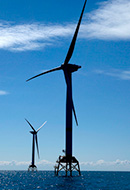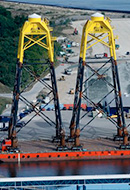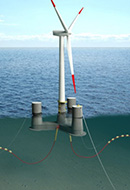Windanker offshore wind farm
Windanker, our third offshore wind farm in the Baltic Sea
Iberdrola projects Offshore wind Germany
The Iberdrola Group is developing its third offshore wind farm in the Baltic, Windanker, with an installed capacity of 315 MW. The company is thus strengthening the Baltic Hub, which will add more than 1,100 MW of installed capacity.

Windanker offshore wind farm




Iberdrola is undertaking a new renewable project, the Windanker offshore wind farm, located in German waters of the Baltic Sea. The company thus continues its commitment to the deployment of renewables in international markets, with this wind farm being the group's third wind project in the Baltic.
Windanker has a planned investment of more than one billion euros and will reach an installed capacity of 315 MW after its commissioning, scheduled for the last quarter of 2026. At the end of 2024, Iberdrola brought the Japanese utility Kansai into this offshore wind project, which was already under construction. The Japanese company co-invested in the wind farm, acquiring a 49% stake, while Iberdrola retained control with the remaining 51%.
The majority of the renewable electricity generated will be traded through long-term power purchase agreements (PPAs) on the German market.
Thanks to the evolution of offshore wind technology and its knowledge of the Baltic Sea, Iberdrola will maximise the efficiency of Windanker, which will incorporate new generation turbines with a unit capacity of approximately 15 MW.
Work on Windanker is making good progress
Still under construction and with geotechnical studies underway, the future wind farm has already received all the necessary approvals to start operations. The latest approval was granted in April 2025 by the German Federal Maritime and Hydrographic Agency (BSH). Prior to that, Iberdrola received authorisation from 50Hertz, the electricity system operator in northeast Germany, of the submarine cable route, essential to connect the offshore substation – about 24 kilometres away – to the German national grid.
Construction will begin on the foundations of the offshore wind farm during the summer of 2025. Installation of the farm's internal cabling will also begin that same year. The Spanish company Windar is already manufacturing the 21 foundation structures (monopiles and transition pieces), while Siemens Gamesa will be in charge of building the wind turbines.
The transport and installation of the monopile foundations and interconnecting cables will be carried out by Van Oord, the same company involved in the development of the Baltic Eagle offshore wind farm. As well as this other Baltic project, the Dutch company will deploy its 8,000 tonne heavy lift vessel, called Svanen, which has installed more than 700 foundations across Europe.
Germany plans to develop 20,000 MW of offshore wind capacity by 2030. This target could be revised upwards following the approval this spring of the need to increase CO2 emission reductions to 65 % by 2030 and 88 % by 2040, with the aim of reaching climate neutrality by 2045, five years earlier than the initial commitments. Regulation in Germany is characterised by stability and predictability, creating a framework of confidence for renewable energy developers.

Construction of an offshore wind plant
Everything about offshore wind farm construction.

Evolution of wind energy in Europe
The European wind market has grown strongly over the last 25 years. Find out more.

Offshore wind turbines foundations
How are offshore wind turbines anchored at sea?

Floating offshore wind
A milestone to boost renewables through innovation.
Strengthening the Baltic Hub
The project will strengthen the Baltic Hub led by the company in Germany, which will add more than 1,100 MW of installed capacity, following a joint investment of around 3.5 billion euros. The Hub is also made up of the Wikinger (350 MW) wind farm, in operation, and Baltic Eagle (476 MW), under construction.
Windanker will also benefit from other synergies during its implementation, as its development coincides with that of the parks in the East Anglia Hub complex in the UK.
Iberdrola, world leader in renewable energies
At Iberdrola, we dare committed to renewable energy more than two decades ago as a fundamental pillar on which to build our safe, clean and competitive business model. Thanks to this vision, we are today world leaders in renewables, reaching 44,478 MW of clean energy in operation at the end of 2024.
This commitment is reflected in our Strategic Plan, in which we will allocate €15.5bn gross to renewables. More than half of this amount is focused on offshore wind in the US, UK, France and Germany; 28% on onshore wind and 18% on solar.




